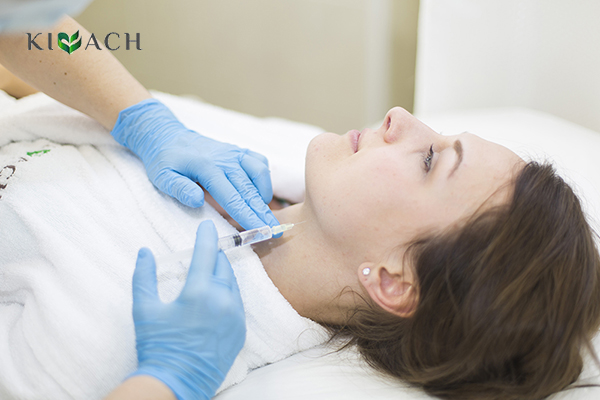What is lymphotropic therapy?
It is a method of treatment for various diseases which is based on injecting drugs into the lymphatic system – the area of maximum concentration of lymphatic nodes and vessels. It has proven to be effective thanks to the connection between organs/tissues and the lymphatic system. This ensures that drugs will be delivered directly to the affected organ.

Lymphotropic therapy at Kivach Clinic
Injecting drugs into the lymphatic system allows doctors to treat not only the source of inflammation, but the whole body as well. This method also has two important advantages:
- Drugs no not affect the digestive system, liver and kidneys.
- Drug concentration remains optimal for 24 hours, which helps lower the amount of drugs taken over 24 hours or the whole course of treatment.
Indications
- Pyogenic diseases (strep throat, tonsillitis, gum, upper or lower jaw inflammation, pyoderma, furunculosis, etc.).
- Diseases of the central nervous system: retinopathy, brain ischemia, conditions after a stroke or injury, migraine, multiple sclerosis, vertebrobasilar insufficiency.
- Respiratory diseases: pneumonia, bronchitis, obstructive syndrome, bronchial asthma.
- Digestive disorders: acute gastric and duodenal ulcer, hepatitis, including viral hepatitis, hepatic steatosis, cirrhosis, chronic pancreatitis.
- Kidney and genitourinary diseases: pyelonephritis, cystitis, urethritis, sexually transmitted diseases, gynecological diseases, prostatitis.
- Musculoskeletal disorders: degenerative changes in the spine, including spinal disk herniation that causes pain and with exacerbation of symptoms, frozen shoulder, arthritis and arthrosis in different areas.
- Vascular diseases: lymphostasis, chronic venous insufficiency, arterial insufficiency (macro- and microangiopathy) of different origin, including diabetes, neuropathy, Raynaud’s disease, trophic ulcers of different origin.
- Viral diseases of different origin: shingles, oral and genital herpes, etc.
About the procedure
What to expect during the procedure?
This type of treatment requires several sessions. The number and periodicity of sessions are determined by a doctor.
The procedure is an injection of a drug into special zones (Yurin’s zones). These zones have the maximum number of lymphatic vessels and nodes, tied to a certain organ. The area of injection is determined depending on the existing disease:
- Submandibular or inguinal lymph nodes.
- Under the mastoid process.
- In the area of the temporal muscle.
- In the projection of the round ligament of the liver.
- Under the xiphoid process.
- Projection of the round ligament of the uterus (for women) and spermatic cord (for men).
- Under the seventh cervical vertebrae.

The injection is given after the application of an anesthetic, so the patient does not feel any discomfort. Should the patient be hypersensitive, he/she might feel mild pain that will last for a very short time.
The procedure lasts 10-30 minutes and is performed once every 24 hours.
Contraindications
- Allergic reaction to an injected drug.
- Postoperative scar after upper and midline laparotomy (only when the injection has to be given in the projection of the round ligament of the liver).
Question-answer
- When can the result be evaluated?
-
The first results will be visible 24 hours after the procedure. The final result can be evaluated at the end of the course of treatment. Depending on the patient’s medical history, prescribed drugs and other methods of treatment that were used, the result can fully develop after the treatment is already over.
- What result should be expected?
-
This method of injecting drugs has proven to be more effective for the treatment of various diseases, compared to traditional intravenous or intramuscular injections. The connection between the lymphatic system and organs makes it possible to deliver the drug exactly to the affected organ, without affecting digestive organs, liver and kidneys.
- Is the procedure safe?
-
The procedure is absolutely safe, and it is well-tolerated by the patients. There might be some reactions specific to each individual patient, but those reactions do not pose any danger to a patient’s health.
- Is the procedure painful?
-
The injection is given after the application of an anesthetic. The patient does not feel any discomfort or might feel mild pain that disappears right after the injection is given.
- How to prepare for the procedure?
-
No special preparation is required.
- How long does the rehabilitation period last?
-
There is no rehabilitation period.
- Are complications possible?
-
There are no complications.
- What ensures that the procedure is successful?
-
- Qualified doctors with extensive practical experience.
- Certified drugs.
- Compliance with the standards of medical care.

